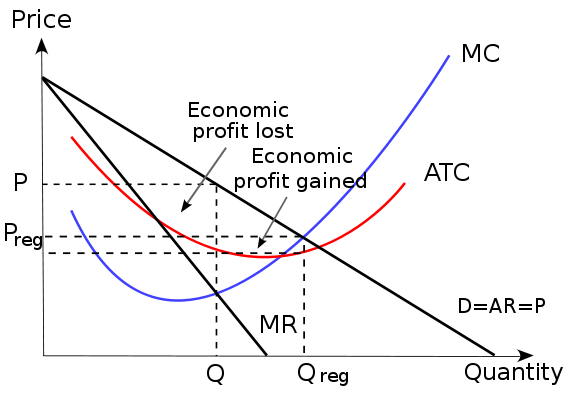Defining Monopoly
A monopoly is an economic market structure where a specific person or enterprise is the only supplier of a particular good.
learning objectives
- Differentiate monopolies and competitive markets
A monopoly is a specific type of economic market structure. A monopoly exists when a specific person or enterprise is the only supplier of a particular good. As a result, monopolies are characterized by a lack of competition within the market producing a good or service.

Monopoly: The graph shows a monopoly and the price (P) and change in price (P reg) as well as the output (Q) and output change (Q reg).
Characteristics of a Monopoly
A monopoly can be recognized by certain characteristics that set it aside from the other market structures:
- Profit maximizer: a monopoly maximizes profits. Due to the lack of competition a firm can charge a set price above what would be charged in a competitive market, thereby maximizing its revenue.
- Price maker: the monopoly decides the price of the good or product being sold. The price is set by determining the quantity in order to demand the price desired by the firm (maximizes revenue).
- High barriers to entry: other sellers are unable to enter the market of the monopoly.
- Single seller: in a monopoly one seller produces all of the output for a good or service. The entire market is served by a single firm. For practical purposes the firm is the same as the industry.
- Price discrimination: in a monopoly the firm can change the price and quantity of the good or service. In an elastic market the firm will sell a high quantity of the good if the price is less. If the price is high, the firm will sell a reduced quantity in an elastic market.
Sources of Monopoly Power
In a monopoly, specific sources generate the individual control of the market. Sources of power include:
- Economies of scale
- Capital requirements
- Technological superiority
- No substitute goods
- Control of natural resources
- Network externalities
- Legal barriers
- Deliberate actions
Monopoly vs. Competitive Market
Monopolies and competitive markets mark the extremes in regards to market structure. There are a few similarities between the two including: the cost functions are the same, both minimize cost and maximize profit, the shutdown decisions are the same, and both are assumed to have perfectly competitive market factors.
However, there are noticeable differences between the two market structures including: marginal revenue and price, product differentiation, number of competitors, barriers to entry, elasticity of demand, excess profits, profit maximization, and the supply curve. The most significant distinction is that a monopoly has a downward sloping demand instead of the “perceived” perfectly elastic curve of the perfectly competitive market.
Key Points
- A monopoly market is characterized by the profit maximizer, price maker, high barriers to entry, single seller, and price discrimination.
- Monopoly characteristics include profit maximizer, price maker, high barriers to entry, single seller, and price discrimination.
- Sources of monopoly power include economies of scale, capital requirements, technological superiority, no substitute goods, control of natural resources, legal barriers, and deliberate actions.
- There are a few similarities between a monopoly and competitive market: the cost functions are the same, both minimize cost and maximize profit, the shutdown decisions are the same, and both are assumed to have perfectly competitive market factors.
- Differences between the two market structures including: marginal revenue and price, product differentiation, number of competitors, barriers to entry, elasticity of demand, excess profits, profit maximization, and the supply curve.
- The most significant distinction is that a monopoly has a downward sloping demand instead of the “perceived” perfectly elastic curve of the perfectly competitive market.
Key Terms
- monopoly: A market where one company is the sole supplier.
- differentiation: The act of distinguishing a product from the others in the market.
LICENSES AND ATTRIBUTIONS
CC LICENSED CONTENT, SPECIFIC ATTRIBUTION
- Monopoly market. Provided by: Wikipedia. Located at: en.Wikipedia.org/wiki/Monopoly_market. License: CC BY-SA: Attribution-ShareAlike
- Perfect competition. Provided by: Wikipedia. Located at: en.Wikipedia.org/wiki/Perfect_competition. License: CC BY-SA: Attribution-ShareAlike
- Monopoly market. Provided by: Wikipedia. Located at: en.Wikipedia.org/wiki/Monopoly_market. License: CC BY-SA: Attribution-ShareAlike
- Boundless. Provided by: Boundless Learning. Located at: www.boundless.com//management...ifferentiation. License: CC BY-SA: Attribution-ShareAlike
- Boundless. Provided by: Boundless Learning. Located at: www.boundless.com//economics/...ition/monopoly. License: CC BY-SA: Attribution-ShareAlike
- Imperfect competition after regulation. Provided by: Wikimedia. Located at: commons.wikimedia.org/wiki/Fi...regulation.svg. License: CC BY-SA: Attribution-ShareAlike



